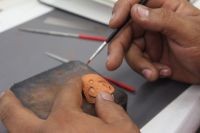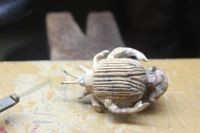How Do You Learn To Make Jewelry? This is a popular question for those eager to craft beautiful adornments. At LEARNS.EDU.VN, we provide comprehensive guidance on jewelry making, from beginner techniques to advanced methods, helping you transform your creative ideas into stunning realities and enhancing your artistry. Explore our curated articles and courses to uncover the secrets of jewelry design, artistic expression, and craftsmanship, and elevate your skills in metalworking.
1. Understanding the Allure of Jewelry Making
Jewelry making isn’t just a craft; it’s an art form that allows you to express your creativity and create wearable masterpieces. Whether you’re drawn to the elegance of wire-wrapped designs or the sophistication of silversmithing, jewelry making offers a fulfilling journey of skill development and artistic satisfaction.
- Expressing Individuality: Jewelry allows you to create pieces that reflect your personal style.
- Developing Creativity: Designing and crafting jewelry enhances your creative thinking.
- Creating Meaningful Gifts: Handmade jewelry makes thoughtful, personalized gifts for loved ones.
2. Exploring Different Jewelry Making Techniques
The world of jewelry making encompasses a wide array of techniques, each offering unique challenges and rewards. Here are some popular methods to explore:
- Wire Wrapping:
- Description: This ancient technique involves shaping and wrapping wire around components without soldering.
- Materials: Various gauges of wire, beads, stones, and basic tools like pliers and cutters.
- Benefits: Simple to learn, requires minimal equipment, and allows for intricate designs.
- Silversmithing and Goldsmithing:
- Description: Shaping precious metals like silver and gold through hammering, casting, soldering, and more.
- Materials: Precious metals, soldering equipment, hammers, anvils, and polishing tools.
- Benefits: Creates high-quality, durable pieces with a professional finish.
- Glass Fusing:
- Description: Melting different types of glass together in a kiln to create unique components.
- Materials: Various colors and types of glass, a kiln, and simple tools.
- Benefits: Allows for vibrant colors and limitless design possibilities.
- Metal Clay:
- Description: Shaping a special type of clay that becomes solid metal after firing in a kiln.
- Materials: Metal clay, a kiln, shaping tools, and finishing supplies.
- Benefits: Easy to shape and manipulate, resulting in solid metal jewelry.
3. Step-by-Step Guide to Getting Started with Jewelry Making
Embarking on your jewelry-making journey can be exciting and rewarding. Here’s a detailed, step-by-step guide to help you get started:
3.1. Determine the Type of Jewelry You Want to Make
Begin by identifying the specific type of jewelry you’re interested in creating. Do you want to craft delicate earrings, bold necklaces, or custom rings? Your choice will determine the necessary tools, materials, and techniques.
3.2. Find Inspiration
Immerse yourself in the world of jewelry by exploring online resources, jewelry stores, and design books. Pinterest, in particular, is a treasure trove of ideas. Note the materials, shapes, and colors that resonate with you.
3.3. Design Your Piece
Sketch your design on paper. This doesn’t need to be a perfect drawing, but it should outline the basic shape, components, and materials you envision. Label each part of the design with the materials you’ll need.
3.4. Acquire Tools and Materials
Gather the necessary tools and materials based on your design. For wire-wrapped jewelry, you’ll need wire, beads, and pliers. For metalwork, you’ll need a soldering torch, metal sheets, and a jeweler’s saw.
3.5. Set Up Your Workspace
Create a dedicated workspace with ample lighting and a stable work surface. A comfortable chair is essential, as you may spend hours crafting your jewelry. Ensure proper ventilation if you plan to solder, sand, or polish materials.
3.6. Start Creating
With your design, materials, and workspace ready, it’s time to start making jewelry. Follow tutorials, take classes, or hire a private instructor to guide you through the process.
4. Essential Tools for Jewelry Making
Having the right tools is crucial for successful jewelry making. Here are some essential tools every beginner should have:
| Tool | Description | Use |
|---|---|---|
| Jeweler’s Saw | A fine-bladed saw used for cutting metal. | Cutting precise shapes and designs in metal sheets. |
| Flush Cutter | Used for cutting wire and metal with a flat, clean edge. | Trimming wire ends and creating clean cuts. |
| Round Nose Pliers | Pliers with rounded jaws for creating loops and curves in wire. | Forming consistent loops for earrings, bracelets, and necklaces. |
| Flat Nose Pliers | Pliers with flat jaws for gripping and manipulating wire. | Holding wire securely and bending it into desired shapes. |
| Chain Nose Pliers | Pliers with tapered jaws for detailed work in tight spaces. | Manipulating small components and reaching into intricate designs. |
| Soldering Torch | A tool that emits a flame for soldering metal pieces together. | Joining metal components to create a strong bond. |
| Anvil | A heavy steel block used as a surface for hammering and shaping metal. | Providing a stable surface for hammering and shaping metal. |
| Polishing Machine | A machine used to buff and polish jewelry to a high shine. | Enhancing the finish and appearance of jewelry. |
| Kiln | A high-temperature oven used for firing metal clay and fusing glass. | Solidifying metal clay and fusing glass components. |
| Magnifying Glass/Lamp | Provides a magnified view and bright light for detailed work. | Assisting in precise work and reducing eye strain. |
| Safety Goggles | Protects eyes from debris and fumes. | Ensuring eye safety during cutting, soldering, and polishing. |
| Dust Mask | Prevents inhalation of dust and particles. | Protecting respiratory health during sanding and polishing. |
| Fire Safety Equipment | Includes a fire extinguisher and a fire-resistant mat. | Ensuring safety when using a soldering torch. |
| Bench Peg | A specialized tool to support the piece while cutting and filing. | Enhancing stability and precision during detailed metalwork. |



5. Understanding the History of Jewelry Making
Jewelry has been an integral part of human culture for millennia. Understanding its history can provide context and inspiration for your own creations.
- Ancient Times: The earliest known jewelry dates back 25,000 years and was made of bones. Ancient Egyptians used ornate gems and stone-carved symbols in talismans to decorate tombs and mummies.
- Classical Era: Greeks wore jewelry to reflect prosperity and wealth, often made of gold and gemstones as offerings to the gods. Romans respected the symbolism of gemstones and melted down gold coins to cast into jewelry.
- Middle Ages: Churches held most of the wealth and ornate jewelry. Nobility and churches looked down on commoners wearing jewelry and enforced this through Sumptuary Laws.
- Renaissance: Jewelry became more accessible, and artists made significant strides in creative designs and wearable artwork.
- Modern Era: Contemporary jewelry continues traditional forms and styles, with innovations like 3D-printed casting and lab-grown gemstones transforming the landscape.
6. Taking Jewelry Making Classes
Enrolling in jewelry-making classes can provide structured learning and hands-on experience. Look for classes that cover various techniques, from traditional metalsmithing to modern resin and clay shaping.
Benefits of Taking Classes:
- Structured Learning: Classes provide a step-by-step approach to learning new techniques.
- Expert Guidance: Instructors offer valuable feedback and tips.
- Hands-On Experience: You gain practical experience with tools and materials.
- Community: Classes provide an opportunity to connect with other jewelry enthusiasts.
7. Making Jewelry as a Hobby vs. Profession
Jewelry making can be both a rewarding hobby and a viable profession. Understanding the differences can help you decide which path is right for you.
Jewelry Making as a Hobby
- Benefits:
- Exploratory Adventure: Allows you to experiment with different techniques and materials.
- Personal Satisfaction: Provides a creative outlet and the joy of making unique pieces.
- Lower Financial Investment: Requires a smaller investment in tools and materials.
- Considerations:
- Limited Income Potential: Primarily for personal use and gifts.
- Variable Time Commitment: Can be pursued at your own pace.
Jewelry Making as a Profession
- Benefits:
- Income Generation: Provides an opportunity to earn a living from your craft.
- Creative Freedom: Allows you to develop your brand and artistic style.
- Professional Growth: Requires continuous learning and skill development.
- Considerations:
- Significant Investment: Requires investment in equipment, marketing, and education.
- Time Commitment: Requires a consistent effort to create, market, and sell your work.
- Business Skills: Requires business acumen to manage finances, sales, and customer relations.
8. Financial Aspects of Jewelry Making
Understanding the financial aspects of jewelry making is essential, whether you’re pursuing it as a hobby or a profession.
Startup Costs
- Tools and Equipment: Essential tools can range from a few hundred to several thousand dollars, depending on the techniques you plan to use.
- Materials: The cost of materials varies depending on the type of metal, gemstones, and other components you choose.
- Workspace: Setting up a dedicated workspace may involve costs for furniture, lighting, and ventilation.
Operating Costs
- Materials Replenishment: Regularly purchasing materials to replenish your inventory.
- Equipment Maintenance: Maintaining and repairing tools and equipment.
- Marketing and Sales: Advertising your work and selling it through online platforms, craft fairs, or retail stores.
Pricing Your Jewelry
- Cost of Materials: Calculate the cost of all materials used in each piece.
- Labor Costs: Estimate the time spent creating each piece and assign an hourly rate.
- Overhead Costs: Include costs for workspace, utilities, and marketing.
- Profit Margin: Add a profit margin to ensure your business is sustainable.
9. Legal and Ethical Considerations
As a jewelry maker, it’s important to be aware of the legal and ethical considerations related to your craft.
Legal Requirements
- Business Licenses: Obtain the necessary licenses and permits to operate a jewelry business.
- Sales Tax: Collect and remit sales tax according to local and state laws.
- Intellectual Property: Protect your designs and trademarks to prevent infringement.
Ethical Considerations
- Sustainable Sourcing: Use ethically sourced materials to support responsible mining and manufacturing practices.
- Fair Labor Practices: Ensure fair labor practices in your supply chain.
- Transparency: Provide accurate information about the materials and processes used in your jewelry.
10. Advanced Techniques in Jewelry Making
Once you’ve mastered the basics, you can explore advanced techniques to elevate your jewelry-making skills.
Enameling
Enameling involves fusing glass powder to metal surfaces to create colorful and durable designs. This technique requires a kiln and specialized enamels.
Stone Setting
Stone setting involves securing gemstones into metal settings. This requires precision and specialized tools like bezel pushers and stone-setting pliers.
Chasing and Repoussé
Chasing and repoussé are techniques used to create raised and recessed designs on metal surfaces. These techniques require specialized hammers and punches.
Filigree
Filigree involves creating intricate designs with fine metal wires. This technique requires patience and precision.
11. Utilizing Online Resources for Jewelry Making
The internet offers a wealth of resources for jewelry makers, from tutorials and forums to online marketplaces.
Online Tutorials
Websites like YouTube, Vimeo, and CreativeLive offer a vast library of jewelry-making tutorials.
Forums and Communities
Online forums and communities like Etsy Forums and Reddit’s r/jewelrymaking provide a space to connect with other jewelry makers, share tips, and ask questions.
Online Marketplaces
Platforms like Etsy, Shopify, and Big Cartel provide a platform to sell your jewelry online.
12. Caring for Your Jewelry
Proper care is essential to maintain the beauty and longevity of your jewelry. Here are some tips:
- Storage: Store jewelry in a dry, airtight container to prevent tarnishing.
- Cleaning: Clean jewelry regularly with a soft cloth and mild soap.
- Avoid Harsh Chemicals: Avoid exposing jewelry to harsh chemicals, such as chlorine and household cleaners.
- Professional Maintenance: Have your jewelry professionally cleaned and inspected periodically.
13. Joining Jewelry Making Communities
Connecting with other jewelry makers can enhance your learning and provide valuable support.
Local Craft Groups
Join local craft groups and guilds to connect with other jewelry makers in your area.
Online Communities
Participate in online communities and forums to share your work, ask questions, and learn from others.
Workshops and Events
Attend workshops and events to learn new techniques and network with other jewelry enthusiasts.
14. Jewelry Making Safety Tips
Safety should always be a top priority when making jewelry. Here are some essential safety tips:
- Eye Protection: Wear safety goggles to protect your eyes from debris and fumes.
- Respiratory Protection: Use a dust mask to prevent inhalation of dust and particles.
- Ventilation: Ensure proper ventilation when soldering, sanding, or polishing materials.
- Fire Safety: Keep a fire extinguisher and fire-resistant mat nearby when using a soldering torch.
- Tool Safety: Use tools properly and maintain them in good condition.
- Chemical Safety: Handle chemicals with care and follow the manufacturer’s instructions.
15. Exploring Different Styles of Jewelry
Jewelry making allows you to explore a variety of styles, each with its own unique aesthetic.
Contemporary Jewelry
Contemporary jewelry often features clean lines, minimalist designs, and innovative materials.
Vintage-Inspired Jewelry
Vintage-inspired jewelry draws inspiration from historical periods and styles, such as Art Deco and Victorian.
Bohemian Jewelry
Bohemian jewelry features natural materials, earthy colors, and free-spirited designs.
Statement Jewelry
Statement jewelry is bold, eye-catching, and designed to make a statement.
16. Jewelry Making Business Tips
If you’re interested in turning your passion for jewelry making into a business, here are some essential tips:
- Develop a Brand: Create a unique brand identity that reflects your style and values.
- Create a Business Plan: Develop a business plan to outline your goals, strategies, and financial projections.
- Market Your Work: Promote your work through online platforms, social media, and local events.
- Provide Excellent Customer Service: Provide excellent customer service to build a loyal customer base.
- Manage Your Finances: Manage your finances carefully to ensure the sustainability of your business.
17. Trends in Jewelry Making
Staying updated with the latest trends in jewelry making can inspire new designs and attract customers.
Sustainable Jewelry
Sustainable jewelry made from recycled materials and ethically sourced gemstones is gaining popularity.
Personalized Jewelry
Personalized jewelry featuring initials, names, and custom designs is in high demand.
Mixed-Metal Jewelry
Mixed-metal jewelry combining different metals like gold, silver, and copper is a trendy choice.
Nature-Inspired Jewelry
Nature-inspired jewelry featuring botanical motifs, animal designs, and natural gemstones is a popular trend.
18. Resources for Further Learning
Here are some resources for further learning and exploration in the world of jewelry making:
- Books: “The Complete Metalsmith” by Tim McCreight, “Jewelry Making: The Complete Guide” by Jinks McGrath.
- Magazines: “Art Jewelry Magazine,” “Lapidary Journal Jewelry Artist.”
- Websites: LEARNS.EDU.VN, The Crucible, Ganoksin.
- Organizations: Jewelry Artisans Guild, Society of North American Goldsmiths (SNAG).
19. Jewelry Making FAQs
19.1. What do you need to make jewelry?
To start making jewelry, you’ll need basic tools like pliers, cutters, and a jeweler’s saw. You’ll also need materials such as wire, beads, and metal sheets.
19.2. What type of jewelry should I learn to make first?
Wire wrapping is the easiest type of jewelry to learn first, as it requires minimal equipment and a low startup cost.
19.3. Is it profitable to make jewelry?
With experience and business savvy, you can become a successful jeweler and add beauty to people’s lives through your creations.
19.4. How do I start a jewelry-making business from home?
Start by developing a business plan, creating a brand identity, and marketing your work online and at local events.
19.5. What are the best materials for beginner jewelry makers?
Copper and brass are excellent materials for beginners, as they are inexpensive and easy to work with.
19.6. Where can I buy jewelry-making supplies?
You can buy jewelry-making supplies at craft stores, online retailers, and specialty jewelry supply stores.
19.7. How do I price my handmade jewelry?
Calculate the cost of materials, labor, and overhead, and add a profit margin to determine your prices.
19.8. What are some common jewelry-making mistakes to avoid?
Avoid using low-quality materials, neglecting safety precautions, and failing to properly finish your pieces.
19.9. How do I clean and care for my handmade jewelry?
Clean your jewelry regularly with a soft cloth and mild soap, and store it in a dry, airtight container.
19.10. How do I stay inspired as a jewelry maker?
Stay inspired by exploring new techniques, attending workshops, and connecting with other jewelry makers.
20. Start Your Jewelry-Making Journey with LEARNS.EDU.VN
Ready to embark on your jewelry-making adventure? At LEARNS.EDU.VN, we offer a wealth of resources to guide you every step of the way. From comprehensive guides to expert tips, we’re here to help you unlock your creative potential and craft stunning jewelry pieces.
Why Choose LEARNS.EDU.VN?
- Comprehensive Guides: Access detailed guides covering a wide range of jewelry-making techniques.
- Expert Tips: Learn from experienced jewelry makers and industry professionals.
- Curated Resources: Discover a curated collection of tools, materials, and supplies.
- Community Support: Connect with a community of passionate jewelry enthusiasts.
Take the Next Step
Visit LEARNS.EDU.VN today to explore our resources and start your jewelry-making journey. Whether you’re a beginner or an experienced maker, we have something to help you elevate your skills and create beautiful, wearable art.
Contact Us:
- Address: 123 Education Way, Learnville, CA 90210, United States
- WhatsApp: +1 555-555-1212
- Website: LEARNS.EDU.VN
Unlock your creativity and transform your vision into reality with learns.edu.vn. We’re here to support you every step of the way.
